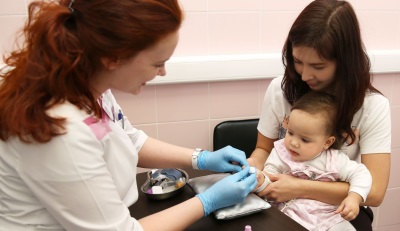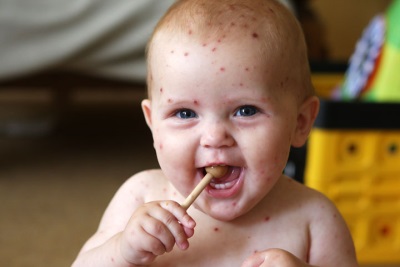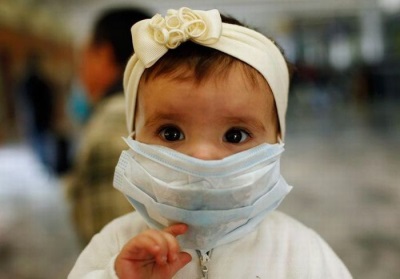The rate of lymphocytes in the blood of a child
Every child has to have a blood test from time to time. Someone is undergoing a routine examination, for example, at 2 years or at 6-7 years. Someone is worried about the symptoms of the disease, and someone is treated and you need to find out how well the recovery is going. One of the most important for immunity and the fight against diseases of blood cells are lymphocytes. What are they responsible for in the children's organism, how many such cells should be normal and what to do when their level deviates?
The role of lymphocytes
So called the group of blood cells, which is one of the types of leukocytes. Such cells do not include granules, so they, together with monocytes, are referred to as agranulocytes. Lymphocytes are important for:
- Creation of local immunity.
- Protect the body through the production of antibodies or direct destruction of foreign agents.
- Control the cells of the body of the child, through which pathological structures are destroyed.
- Formation of immunity after illness or vaccine administration.
Watch a short video showing lymphocyte activity:
Types of lymphocytes
Depending on the place of stay and function, all leukocytes are divided into:
- B cells. They are mainly in the lymph nodes and make up about 8-20% of all lymphocytes. The main task of these cells is to provide humoral immunity. When B-lymphocytes independently contact antigens or T-lymphocytes stimulate them, the production of antibodies begins. Also isolated In-cell memory. Upon encountering the causative agent of infection, such cells record information about it, due to which children receive post-infectious and post-vaccination immunity.
- T cells. Their main location is the thymus, and the main function is to provide cellular immunity. Such lymphocytes are the most numerous, since they make up to 80% of all cells of this species. They are divided into T-killers (the main "work" of such lymphocytes is the destruction of pathogenic cells), T-helpers (such lymphocytes help T-killers and secrete active substances) and T-suppressors (these cells suppress immune reactions so that healthy cells are not destroyed).
- NK cells. Such lymphocytes destroy the child’s own cells that are infected or transformed into tumor cells. They occupy less than 10-20% of all lymphocytes.
Normal levels of lymphocytes in children
A normal indicator for a child at different ages will be the following percentage of lymphocytes:
|
Have a newborn |
From 16% to 32% |
|
Have a baby from 4-5 days of life |
From 30% to 50% |
|
Have an infant with 10 days of life |
From 40% to 60% |
|
A child up to a year older than 1 month |
From 45% to 60% |
|
In children older than one year |
From 45% to 65% |
|
In children over 5 years |
From 35% to 55% |
|
In children over 10 years old |
From 30% to 45% |
The excess of the upper limit is called lymphocytosis, and if the level of lymphocytes does not reach the lower limit of the norm, this condition is called "lymphopenia" or "lymphocytopenia».
How to determine lymphocytes in children
The first assessment of the level of lymphocytes is carried out according to a general blood test. At the same time, they take into account the percentage of other leukocytes (the entire leukogram is evaluated), as well as the presence of leukocytosis, increased ESR, and other changes.
Also in the form it can be noted that atypical lymphocytes are found in the blood (they differ in large size and irregular shape).
If there is evidence, the child is sent for a more detailed examination of the immune system. Special analyzes count the number of B-and T-cells separately, determine the level of immunoglobulins, the number of activated B-lymphocytes and other indicators. Such studies help in the diagnosis of immunodeficiency, autoimmune processes and other pathologies.
Lymphocytosis
An increased level of lymphocytes in a child’s blood can be caused by increased lymphocyte count (such lymphocytosis is called absolute) and reduced neutrophil count (this lymphocytosis is relative, since in reality the number of lymphocytes does not exceed the norm, but only looks like this because of a different redistribution of different types of white blood cells in the leukogram).
The cause of lymphocytosis in a child is:
- SARS, influenza, measles, chicken pox, adenoviral and other viral infections.
- Toxoplasmosis and other parasitic diseases, as well as infection with protozoa.
- Tuberculosis.
- Lymphocytic leukemia and other tumors of the blood-forming organs.
- Vitamin B12 depletion and deficiency.
- Lead poisoning, arsenic and some other poisons.
- Autoimmune diseases.
- Hyperfunction of the thyroid gland.
- Condition after splenectomy.
- Acceptance of antiepileptic, hormonal, antimicrobial and other drugs.
You can suspect lymphocytosis by the symptoms of the underlying disease, for example, by fever, rash, enlarged lymph nodes and other signs. If a baby has an excess of lymphocytes, it is important to immediately consult a doctor.
Lymphopenia
If the baby’s lymphocytes are produced in insufficient quantities, this lymphopenia is called absolute. In cases where a low percentage of lymphocytes is due to an increased number of neutrophils, it is diagnosed relative lymphocytopenia.
The reason for the decrease in the level of lymphocytes in a child is:
- Congenital immunodeficiency.
- Acute surgical pathology.
- HIV infection, measles, tuberculosis and some other infectious diseases.
- Malnutrition or transferred stress.
- Aplastic anemia.
- Chemotherapy or treatment with immunosuppressants.
- Systemic disease.
- Extensive burns.
- Radiation sickness.
- Thymus pathologies.
- Injuries to the lymph nodes.
- Enteropathy.
- Lymphoma.
- Renal failure.
Also the number of lymphocytes is reduced during recovery from an infectious disease, when the "old" lymphocytes are destroyed, and the "new" has not yet entered the blood in sufficient quantities.
We recommend to watch the documentary "The body's defenses. The theory of immunity"
Specific symptoms in lymphopenia are not detected. A child with reduced lymphocytes may shrink the lymph nodes, develop lesions of the oral mucosa. Also, these children are often pale or icteric staining of the skin, there are frequent acute respiratory viral infections and spleen increases.
Having found a deficiency of lymphocytes in a child, it is important to find out the cause of such a condition as soon as possible, because such a baby has weakened defenses and there is a high risk of attaching an infection. After additional tests and expert advice, the child is prescribed a suitable treatment, taking into account the cause of lymphopenia. Sometimes it is necessary to introduce immunoglobulins or transplant bone marrow.
More information about the general analysis of blood, see the transfer of Dr. Komarovsky.
















